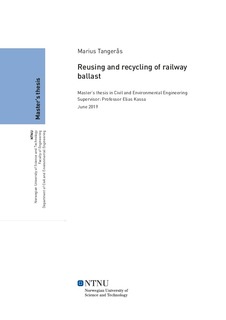Reusing and recycling of railway ballast
Abstract
Målet med denne forskningen er å undersøke muligheter ved gjenbruk og gjenvinning avbrukt jernbaneballast, ved å endre egenskapene og stivheten til ballasten. Litteratur,laboratorie tester og korte intervjuer er benyttet for å diskutere dette temaet.Egenskaper av brukt ballast er undersøkt ved laboratorie tester, ved å benytte standardfor nyprodusert ballast. Dette ga en oversikt over kvaliteten på ballastlaget og indikertemengden av materiale som vil bli fjernet under en ballast rense operasjon.For å modifisere materialene har flere bindemidler vært benyttet. Effekten av dem harblitt undersøkt med gjentakende treaksiale last tester. De måler bøyning og blir brukt tilå regne ut stivhet og permanent deformasjon. Resultatene viste at avhengig avbindemiddel kan ballasten øke eller redusere stivhetene flere ganger verdien avubehandlet ballast. Dette åpner opp muligheter for jernbaneforetakene til å endre linjerog gjøre det enklere å løse problemer ved overgangssoner med ulik stivhet.Den permanente deformasjonen av ballasten viste også effekt av stabilisering medbindemidler. Effekten var ikke like stor som for stivhet, men markant nok til å bli ansettsom en mulig løsning for både nye og gamle jernbanelinjer.Forskningen inkluderer bindemidler som polyurethane (Elastotrack), organosilan(Zycobond), lignosulfonat (Dustex) og bitumen (70/100 og 160/220).
Nøkkelord: Jernbaneballast, knust pukk, stabilisering, treaksiale tester The aim of this study is to research the possibilities of reusing and recycling of usedrailway ballast, by modifying its properties and stiffening the ballast. Literature review,laboratory testing and short interviews has been used to discuss this subject.Properties of the used ballast is investigated through laboratory tests, using thestandards for newly produced aggregates. This gave an overview of the current quality ofthe ballast layer and indicated the amount of material that would be removed during aballast cleaning operation.To modify the materials, several binding agents has been used. The effect of them wasinvestigated by using repeated load triaxial test, measuring deflection to calculatestiffness and permanent deformation. The results showed that dependent on the binder,the ballast can increase or reduce the stiffness several times the value of untreatedmaterial. This opens possibilities for the railway agencies to greatly modify their lines andcould make it easier to solve issues in transition zones of different stiffness.The permanent deformation of the ballast also showed effect of stabilization with bindingagents. The effects were not as severe as for material stiffness, but significant enough tobe evaluated as possible treatment procedure for either new or old railway lines.The research includes binding agents as polyurethane (Elastotrack), organosilanes(Zycobond), lignosulphonate (Dustex) and bitumen (70/100 and 160/220).
Keywords: Railway ballast, Crushed rock, Stabilization, Repeated triaxial load test
